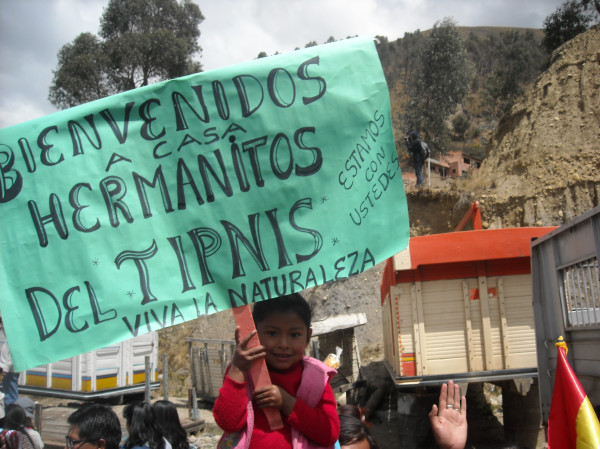This post is part of our special coverage Indigenous Rights.
The indigenous march in defense of the Indigenous Territory and National Park Isiboro Sécuro (TIPNIS for its initials in Spanish) reached its final destination on October 19, 2011, when it arrived at the seat of government in La Paz, Bolivia.
Despite meeting one of its objectives, the marchers still have hopes of meeting with President Evo Morales face-to-face to discuss the 16-point list of demands, including the definitive halt in the construction of the section of the highway that would cut through the heart of their territory.
When word arrived that the march was approaching the city, residents began to prepare the grand reception. Some even traveled to meet the marchers in localities in the Yungas region, such as Tonny Lopez, who posted a few photos of the march's stop in Coroico. When the march passed through “La Cumbre,” which is the highest point of the march sitting at approximately 4,700 meters above sea level, many of the indigenous, who come from the lowland region of Bolivia, had trouble adjusting to the high elevation.
Eighty women from the nearby market of Urujara arrived to this mountainous region to show solidarity and provide a meal of rice soup and sandwiches for the marchers. In this video interview by the user En la UPEA, one of the women says that she feels sorry for the marchers for how long their journey has been; the women of the market will provide meals over two days:
Ever since the police repression of the marchers in the town of Yucumo on September 25, there has been even more public support for the marches and their demands. In light of this police repression, and the public declarations by Morales and his ministers labeling the marchers everything from being misled by NGOs to being “tourists,” many people began to wonder how they would be received by the government when they did arrive.
Manuel Alfaro (@_rogermanuel) asks [es]:
Despues de decirles traficantes, maleantes, pagados, en fin haberlos descalificado a diario, como recibira evo a los indigenas del #TIPNIS ?
While there was a question about how the country's first indigenous president would receive the marchers, there was no question how the city of La Paz would greet the approximately thousand-strong group that had been traveling over 600 kilometers for more than 60 days.
Since early in the morning, residents started to line the streets preparing water and food, as well as Bolivian flags and signs of encouragement. It was a true heroes’ welcome. Jose Luis Chuquimia (@chuquijosel) was in the streets and described what he saw [es]:
las calles pacenhas….quedaron flores, mixtura, banderas de papel…lagrimas, abrazos…sonrisas..pasos que calan historias #TIPNIS ES VIDA
Many others from the Bolivian Twitter community also were present throughout the day reporting from the city streets. Several took photographs and posted them to Twitter. Nicole Gerke (@nicolegerke) posted photos of the crowd joining the march and of public support from the Afro-Bolivian community.
Others like Mariana (@ama1607) posted this photograph of women waiting for the marchers with flowers:
Journalist and blogger Boris Miranda (@ivanbor) also accompanied the march and captured images of some of the well-wishers along the route:

"Welcome home brothers from the TIPNIS. We support you. Long live Nature" Photo by @ivanbor and used with permission.
It was a photograph taken by Centa Rek, a Senator from the opposition party, that elicited an active response from the Twitter community. Throughout the day, many were commenting about the appearance of opportunists that took advantage of the outpouring of support as a way to benefit themselves. Twitter user @AndreaMiCaHe had some words of advice [es]:
Politicos oportunistas respeten marcha dl #TIPNIS no vayan a la marcha a solo aparecer n la foto, oposicion inutil xfavor manter distancia!!
Twitter user Alexis Argüello (@alexisarguello) used a play-on-words to [es] to describe those jumping on the bandwagon, calling them “OporTIPNIStas” instead of the Spanish word of “oportunistas” (opportunists).
The indigenous marchers arrived to the Plaza Murillo, which sits facing the Presidential Palace and Congress, in anticipation of a meeting with the President. No one is quite sure what will happen next and the indigenous marchers vow to not leave La Paz without a law that prohibits the construction of the highway through their territory.
Ana Rosa López Villegas of the blog Mi Voz, Mi Palabra summarizes the hopes of the marchers and the general public that supports them [es]:
Hace dos meses que caminan y que claman, hace dos meses que quieren ser escuchados. Hace más de dos meses que buscan en las pupilas oscuras y la piel cobriza de su “hermano” Presidente, el respaldo que los acoja en su legítima demanda.
This post is part of our special coverage Indigenous Rights.









7 comments